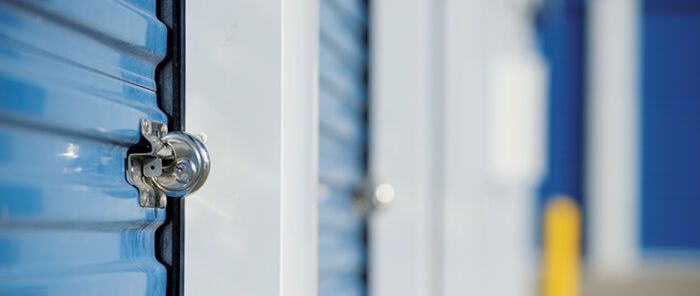Storage lots can be used to store a variety of items, including vehicles, stock, and equipment. A properly designed storage lot uses several security measures that make theft difficult.
Below, we outline some key solutions that can be implemented to help secure your storage lot, but each business is unique and may need to use a combination of techniques to ensure their valuables are protected.
Physical barriers and landscaping
Physical barriers are used to prevent both vehicle access and the removal of equipment from an open lot. Types of barriers include concrete barriers and blocks. Landscaping can also be an effective tool. For instance, to help prevent theft, perimeter ditches could be created or large rocks could be strategically placed to prevent vehicle traffic. You can also move temporary barriers around as necessary to block entrances or to create a barrier along the side of an open lot.
Fencing
Fences are used to prevent pedestrian and vehicle traffic from entering a lot. Steel posts joined with cable or chain may provide adequate protection. Chain link is the most common fencing material, but other options include iron, masonry, and wood.
Unfortunately, chain link fences can be cut, and therefore added security may be required. Installing additional horizontal steel pipes between the posts makes it more difficult to remove items through a cut fence. To deter intruders from climbing over a fence, barb wire can be installed at the top of fencing. Check with local authorities to see if barb wire is permitted. Depending on the location, barb wire may not be allowed.
Fence gates should be constructed to the same or higher standards as a fence and equipped with good quality professional series padlocks. If a chain is used to lock the gate, consider using a high-grade steel chain.
Lighting
Since good lighting can discourage intruders, positioning lighting to cover all areas of a storage lot can be very effective. Perimeter lighting can also be installed to help reduce dark areas where intruders can hide. Lights should operate from dusk to dawn.
Securing items
Items on an unfenced lot can be secured with a high-grade steel chain or high-quality steel cable, along with high quality professional series padlocks. The items can be secured together or to a solid object on a lot. Keep in mind that this may not be adequate for large high target theft items such as All-Terrain Vehicles (ATVs).
Intrusion alarms
Install intrusion alarms, also known as burglar alarms, for additional security. Intrusion alarms are designed to detect intruders, sound local alarms, and notify a monitoring company. Some common methods for alarming a fenced compound include:
- Fence monitoring have alarm wires that are strung through a fence. An alarm is triggered if wires are cut.
- Photoelectric beam transmitters and receivers can be placed inside the perimeter of a fence. An alarm is triggered when a beam is broken.
- Motion sensors can be placed in the compound to trigger the alarm if an intruder is detected.
If a lot is not fenced, individual items can be protected using a closed loop alarm system, which is an alarm cable strung through items for protection. When a cable is removed, the alarm is triggered. Some high target theft items may require both a fenced compound and a closed loop alarm system.
Security cameras
Security cameras, also known as video surveillance or closed-circuit television (CCTV), can be used to monitor and record activity on your property. Owners, security guards, or a monitoring company can watch live activity or replay footage. The cameras can also notify employees if motion is detected. Video surveillance may deter intruders who do not want their faces and actions to be used for proof of crime.
Warning signage
Place large, visible signs on your premises to communicate with the general public. Examples of signage can include open/closed, hours of operation, under surveillance, private property, no trespassing, authorized personnel only, and danger – keep out.
Guard dogs
We do not recommend the use of guard dogs. Animal owners are legally responsible for the actions of their animal if they know the animal has vicious tendencies. In liability coverage terms, that means you acknowledge the hazard exists when employing guard dogs, and you are completely liable when a dog inflicts damage or injury to a victim.
Guard dogs require special precautions to ensure the public’s safety and most security concerns can be addressed by methods other than a guard dog.
Make sure your business is covered
While it’s important that you take the necessary precautions against theft at your storage lot, things can sometimes go wrong despite your best efforts. That’s why having the appropriate insurance coverage is so important. With the right insurance policy in place, you can rest easy knowing that your business is prepared for the unexpected. Learn more by visiting our business insurance page today!
This blog is provided for information only and is not a substitute for professional advice. We make no representations or warranties regarding the accuracy or completeness of the information and will not be responsible for any loss arising out of reliance on the information.






